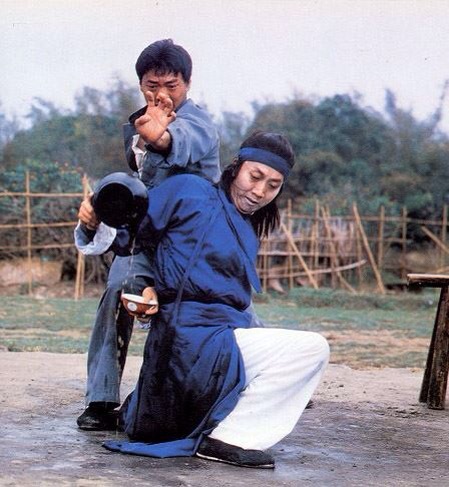Hello out there! I’m your Uncle Sickness, here to help improve your terrible kung fu! Stupid? No good? With no talent? You shouldn’t talk like that! We can fix your problem very quickly! Just follow these basic methods & you’ll improve with time. Ok? No problems, at all. You can go here & find the more advanced Methods that are built on the foundation of the ones listed below. Remember the Xingyiquan Proverb: “It cannot be rushed or forced.” Practice each of the Methods thoroughly, until you’re familiar & comfortable with them. Once you have a good grasp of each one, move on to the next. Proceeding step-by-step will always yield excellent results.
•The Basics of Breathing•
The most basic Breathing Exercise is called “自然吸/Zi Ran Xi,” or Natural Breathing. From one perspective, “Natural Breathing” is the way a given person normally breathes, their habits & reflexes, with no attempts to control or alter the breathing. But, for our purposes, Natural Breathing will always refer to the methodology presented here. These Eight Characters on Natural Breathing outline a clear & simple program for improving overall respiratory efficiency. All inhalation must be done through the nose, all exhalation may be done through either the nose or mouth. As with any type of health building exercise, physical & psychological tension should be reduced as much as possible, depending on the needs & goals of the practitioner.
•靜 Jing/Quiet – Avoid ragged, noisy breathing at all costs. Unless you’re suffering sinus congestion, it should be impossible to hear your breathing.
•細 Xi/Fine – Keep yourself relaxed physically. Loosen up the chest, throat, & face. No flaring the nostrils or pursing the lips.
•深 Shen/Deep – Fill the lungs as much as you can without undue effort. No assisting, helping, or playing with the breathing. Let the act of dedicated breathing improve the execution of breathing naturally, over time.
•長 Chang/Long – The breath should feel as though it fills the lungs from bottom to top.
•悠 You/Continuous – Avoid any pause or stop in the rhythm of inhalation & exhalation.
•勻 Yun/Even – Inhalation & exhalation together make breathing. Ideally, both are equal in-depth & length.
•緩 Huan/Slow – Let the breath enter & exit the lungs at a natural pace. Give the inhalation plenty of time to fill the lungs, patiently let the exhalation drain the lungs.
•綿 Mian/Soft – Physical relaxation is key to any practice involving the training of the internal body.
As you practice with these Eight Characters in mind, you should notice improvements in energy level, alertness, relaxation, & mood. Physical relaxation is probably the most immediately noticeable effect of this dedicated breathing practice. Most conveniently, it can be practiced while sitting, standing, walking, or lying down, making this an extremely practical basic exercise that naturally leads into the more advanced methods.
•氣功練習二十四禁令/Qigong Lianxi Er Shi Si Jinling – The Twenty Four Prohibitions of Qigong Practice•
Take a look at the Twenty four Prohibitions of Qigong Practice before beginning to learn any new routine.
•治病的六字訣氣功/Zhibing de Liu Zi Jue Qigong – Illness Treating Six Character Secret Qigong•
肝臟:發「噓」音 治肝與膽的疾病
Liver: Issue the “Xū” (需, Xū) sound to manage Liver & Gallbladder ailments
心臟:發「呵」音 治心與小腸的疾病
Heart: Issue the “Hē” (喝, Hē) sound to manage Heart & Small Intestine ailments
脾臟:發「呼」音 治脾與胃的疾病
Spleen: Issue the “Hū” (忽, Hū) sound to manage Spleen & Stomach ailments
肺臟:發「呬」音 治肺與大腸的疾病
Lungs: Issue the “Xì” (四, Sì) sound to manage Lung & Large Intestine ailments
腎臟:發「吹」音 治腎與膀胱的疾病
Kidneys: Issue the “Chuī” (炊, Chuī) sound to manage Kidney & Bladder ailments
三焦:發「嘻」音 治三焦與心包的疾病
Triple Burner: Issue the “Xī” (西, Xī) sound to manage Triple Burner & Pericardium ailments
•靜心要點/Jing Xin Yao Dian – Essential Points on Meditation•
心定, 神寧; 神寧, 心安; 心安, 清靜; 清靜, 無物; 無物, 氣行; 氣行, 絕象; 絕象, 覺明; 覺明, 則神氣相通, 萬物歸根矣。
The mind is fixed, the spirit is reposed; the spirit is reposed, the mind is still; the mind is still, then peaceful & quiet; peaceful & quiet, then no things; no things, then the Qi moves; the Qi moves, then images are exterminated; when images are exterminated, then consciousness is clear; conscious clarity, then the spirit & qi are mutually connected, & innumerable things return to their origins.
You can take a look at this post on the Essential Points for a more detailed explanation of this fantastic piece.
•The Jade Prism Inscription on 行氣/Xingqi – Circulating Qi•
Here’s my translation of the Inscription
Possibly the oldest written reference to Qi based meditation, dating from approximately 400 b.c., this short text outlines what appears to be the Small Circulation Meditation in just a few characters. Easy to memorize & put into practice once you’ve gotten the knack, this piece is worthy of repeated study by the serious student of meditation.
•呂洞賓百字碑/Lu Dongbin Baizibei – Lu Dongbin’s One Hundred Character Stele•
Here’s my translation of Lu Dongbin’s One Hundred Character Stele
Lu Dongbin was a Tang Dynasty historical figure & member of the Eight Immortals of Daoist religion. He is considered the patriarch of various sects, & there are numerous works attributed to him over the centuries. The One Hundred Character Stele is a short poem relating the basis of self-cultivation.
調息六字/Tiao Xi Liu Zi – Six Characters on Regulating the Breath
Learn the specifics by reading this post, then start your training. The concepts outlined by these Six Characters will bridge the gap between the action of breathing & its effect on the mind. The interconnected nature of physical life will be clearly demonstrated by the effect these methods have on the quality of your mind.


Yesssss!! This is great!
LikeLike